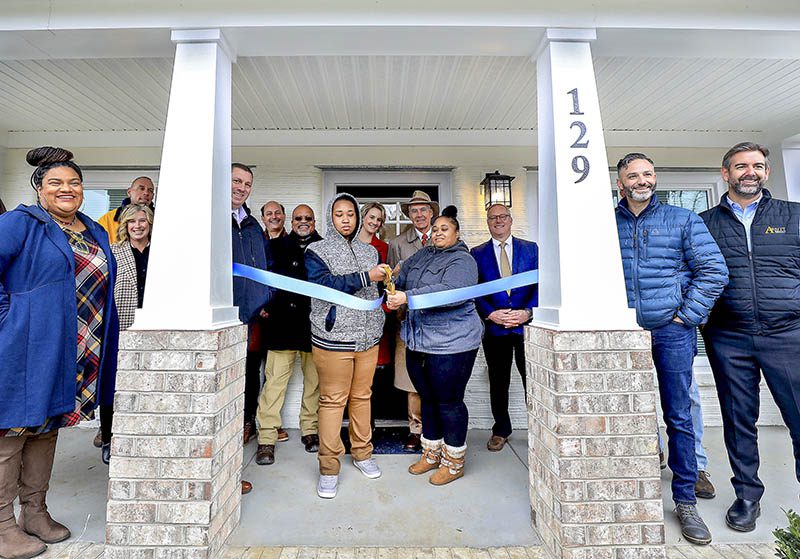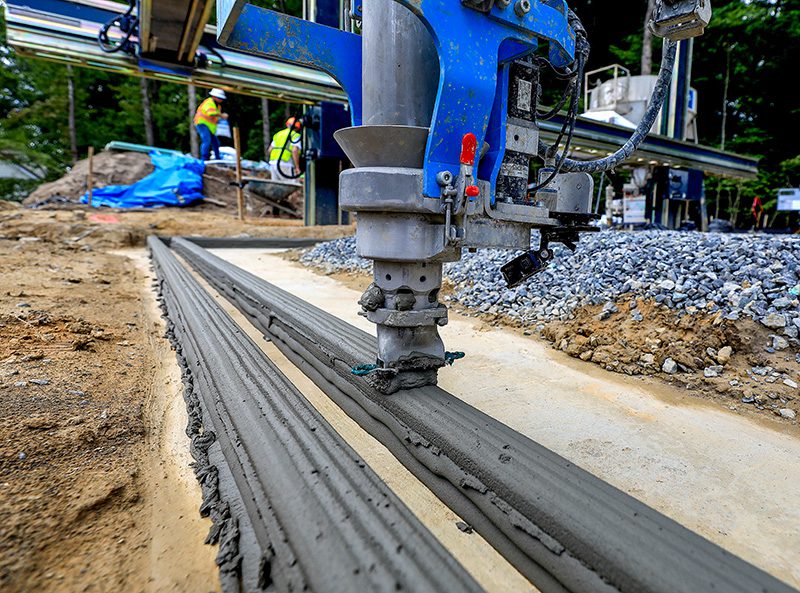Williamsburg is notable for it’s significant role in American colonial history, it’s lively tourism experiences, and it’s proximity to other destinations in the region’s Historic Triangle. What people might not know is that it hosted the construction of the first 3D printed Habitat for Humanity house.
Habitat for Humanity Peninsula and Greater Williamsburg, celebrated the first 3D printed house in December 2021, when it was presented to April Stringfield and her son.
Stringfield, the Surry native, purchased the house via the Habitat Homebuyer Program which requires purchasers to complete financial literacy and basic home repair classes. Homebuyers must also provide 300 volunteer hours. Called “sweat equity” they can work on a home and at the organization’s ReStore thrift stores. As a hotel laundry supervisor, Stringfield’s monthly mortgage payments are no more than 30% of her income, including her real estate taxes and homeowner’s insurance.
The presentation event was attended by officials from Habitat for Humanity International and government representatives. The local Habitat non-profit serves Hampton, Newport News, Poquoson and Williamsburg and the counties of Charles City, James City, New Kent, and York.
Habitat partnered with Alquist, a Colorado-based 3D concrete printing home construction company to build the houses, said Craig Meadows, chief construction officer for the organization.
During the home’s construction, a specially formulated concrete is extruded via large-scale robotics systems, in multiple layers to form the home’s walls, foundation, and footing. The printing process requires minimal supervision, with each layer measuring about three-quarters of an inch tall. A typical house would have roughly 156 layers, according to Meadows.
The house’s successful completion prompted the construction of two more 3D-printed homes, right next door to each other, in Newport News’ Southeast community. The land was donated by the Newport News Redevelopment and Housing Authority in 2023.

Dedication ceremony for the Habitat for Humanity’s 3D printed home in Williamsburg for homeowner April Tuesday December 21, 2021.
Each 1,200 square-foot home has three bedrooms and two bathrooms.
The house’s exterior was printed in 28 hours, which is the equivalent of a four-week reduction in a traditional build process. It’s also about 15% cheaper to build, Meadows shared.
A major advantage is that the homes are unusually durable and energy efficient, he added.
Each Habitat home is certified through EarthCraft, a voluntary green building program designed to ensure healthy, comfortable living spaces with lower utility costs and reduced environmental impact.
In addition, Alquist equips every home it builds with a 3D printer installed in the kitchen for emergency repairs. Homeowners receive a digital file enabling them to print items like doorknobs and light switch covers as needed.
The local organization is working with Virginia Tech to further the technology. The Virginia Tech Center for Housing Research will perform long-term testing inside the first home, using Virginia Tech’s proprietary Raspberry Pi-based monitoring system, Meadows noted.
The system monitors and verifies air quality, temperature, humidity, lighting, sound, vibration, and various gases. It also integrates with security and alarm systems for motion detection in designated areas, while supporting occupant comfort analysis and optimizing energy consumption, according to Habitat.
Alquist spent more than four years researching 3D printing technology, partnering with firms such as COBOD, Black Buffalo 3D, and Atlas Community Studios, according to the Greg Galifianakis, spokesperson for the company.

Another benefit of the technology is design flexibility at minimal additional cost. This allows for unique features that were once too expensive to be easily included in any floor plan.
The also industry draws a larger workforce by offering high-tech jobs that appeal to younger workers.
The local homes spurred ideas in places like Greenley, Colorado, where an entire neighborhood of nearly 500 3D printed homes is set to be completed in 2029.
Locally, plans are to develop 3D printed prefabricated houses, Meadows said.
“It’s very possible the first ever prefab house could be printed in James City County,” he said.


